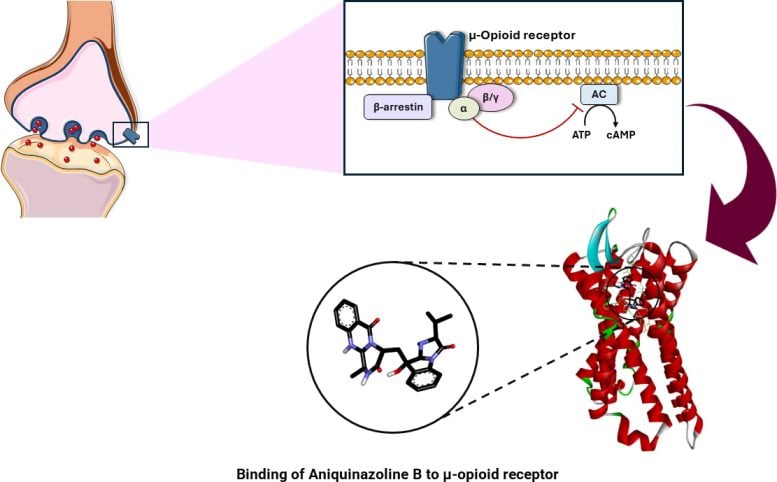Opioids such as morphine are effective painkillers, but they are subject to widespread addiction and cause serious side effects, including respiratory depression. This was particularly evident during the US opioid crisis, which claimed approximately 645,000 lives between 1999 and 2021. After rigorous testing, including using the MOGON supercomputer to perform more than 750,000 calculations for each substance, researchers at Johannes Gutenberg University Mainz identified an alternative substance, aniquinazoline B, from the marine fungus Aspergillus nidulans, that binds to opioid receptors and may offer a potential alternative to opioids with fewer side effects.
Researchers at the University of Mainz have discovered a natural compound that could offer a long-term alternative to opioids and help ease the opioid crisis.
Opioids have been used as effective painkillers for many years due to their remarkable pharmacological properties. Morphine, a classic example, was first isolated and synthesized in the early 19th century and provides important analgesic effects to patients in the final stages of serious illnesses.
However, if used improperly, opioids can cause addiction and very serious side effects, such as respiratory depression. In the United States, opioids were once widely promoted through the media, and as a result, they were often prescribed to treat minor illnesses. According to the Centers for Disease Control and Prevention (CDC), there were approximately 645,000 deaths from opioid overdoses in the United States between 1999 and 2021.
And the opioid crisis has also arrived in Germany: the main problem is street drugs and in particular the fact that the synthetic opioid heroin is mixed with other cheaper opioids, for example. FentanylTaking 200 milligrams of heroin is fatal, but just 2 milligrams of fentanyl can be lethal. In 2022, more than 1,000 people died in Germany from taking opioids.
From a database of 40,000 natural substances
Governments have introduced measures to contain the epidemic. However, opioid addiction rates are high and some people suffer from extreme pain that needs to be relieved. Safe painkillers are therefore urgently needed. Researchers from the Johannes Gutenberg University Mainz (JGU) with funding from the research training group “Life Sciences – Life Writing” funded by the German Research Foundation (DFG) have made a step towards this goal.
“A natural substance called aniquinazoline B, isolated from a marine fungus, Aspergillus nidulans “It stimulates opioid receptors and could potentially be used as an alternative to opioids in the future,” explained Roxana Damiescu, part of the research team led by Professor Thomas Effers.
To find new compounds, the team began with a chemical database of more than 40,000 natural substances. Their goal was to determine how effectively each substance bound to its corresponding receptor. They also needed to determine whether they possessed the properties required for a drug.
Such compounds must be water-soluble to some extent. The study requires calculations in the form of approximations, and the more frequently they are performed, the more accurate the results will be. Each substance was subject to around 750,000 individual calculations. Such a huge number of calculations far exceeds the capacity of a standard PC. That’s why the team made use of JGU’s MOGON supercomputer. The top 100 candidate products obtained from these calculations were then evaluated using other analytical methods.
Further detailed investigations in the lab
The final top ten substances were then taken to the laboratory for biochemical analysis. The first priority was to establish safety: using a preparation of human kidney cells, the researchers looked at whether high concentrations of each substance were toxic to the cells and would kill them. Finally, the other two aspects had to be tested.
“We needed to confirm that the high binding energy of substances to pain receptors predicted by theoretical calculations is actually produced in the real physical world,” says Professor Thomas Effers, head of the JGU School of Pharmacy and Biology. But it’s not enough for a substance to bind to a receptor: the binding must also affect the receptor’s function.
The researchers then used a second test system to assess whether there was any inhibition of biological activity, such as that which occurs during opioid use. One of the two compounds passed all the tests with flying colors: aniquinazoline B, a substance found in a marine fungus. Aspergillus nidulans“Our research shows that this substance can have similar effects to opioids, but at the same time, with far fewer unwanted reactions,” concludes Roxana Damièscu.
Reference: “The fungal natural product aniquinazoline B activates μ-opioid receptors” by Roxana Damiescu, Mohamed Elbadawi, Mona Dawood, Sabine M. Klauk, Gerhard Bringmann, and Thomas Effers, May 23, 2024, Chemicals Chemistry.
DOI: 10.1002/cmdc.202400213



